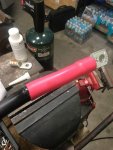- 1,958
- 427
- 68
- Location
- Culver City, CA
What size gauge cable and what style ring terminal crimp connector is required for battery cables?
Steel Soldiers now has a few new forums, read more about it at: New Munitions Forums!

I don't crimp any more I solder and then use 3 layer (not three layers) heat tubing that has a heat activated potting compound inside that make the connection complely waterproof. I also use 00 welding cable. I use pre tinned terminals with solder in pre measured slugs that give just the right amount of solder and it doesn't require you to hold the terminal at soldering temp for more than a few seconds.
Terminals:
Heavy-duty Copper Lugs
Solder slugs:
Terminal Solder Slugs
Heat shrink tubing:
Shrink Tube - Triple Wall
This costs more money but you will NEVER have to replace them or have troubles with them.

I agree if you use solder fed in by hand, the solder travels up the wire but using the plugs there is just enough solder to make a good connection. You are not heating the wire directly so the solder won't travel unless you overheat the connection. I use welding cable as it has the most flexibility.Soldering is probably the best approach for most of us, since the proper crimping tools would be cost prohibitive.
Soldering has a couple of problems, quality control and vibration failure at the joint where the solder ends, ever noticed how stiff that part of the connection is?
The original mil spec battery cables are crimped.

I don't crimp any more I solder and then use 3 layer (not three layers) heat tubing that has a heat activated potting compound inside that make the connection complely waterproof. I also use 00 welding cable. I use pre tinned terminals with solder in pre measured slugs that give just the right amount of solder and it doesn't require you to hold the terminal at soldering temp for more than a few seconds.
Terminals:
Heavy-duty Copper Lugs
Solder slugs:
Terminal Solder Slugs
Heat shrink tubing:
Shrink Tube - Triple Wall
This costs more money but you will NEVER have to replace them or have troubles with them.
Hey All, Im a noob to electrical cables. i want to repair my standard battery cable as one lug broke off. if the standard is 0 gauge, how come when I want to by a lug here http://www.delcity.net/store/Heavy!duty-Copper-Lugs/p_1012.h_92199.a_1.t_1 it has 1 gauge then 1/0 gauge. What size do I need? Also I'm guessing the lug will be the same size but bonus if you tell me which one and shrink to get. Thanks!
Just an FYI, 1 and 1/0 are not the same, fairly big difference. Some wire sizes, from smaller to bigger, 4, 3, 2, 1, then 1/0, 2/0, 3/0, 4/0... the numerical order vs size “reverses” once you get into the 0 sizes.Hey All, Im a noob to electrical cables. i want to repair my standard battery cable as one lug broke off. if the standard is 0 gauge, how come when I want to by a lug here http://www.delcity.net/store/Heavy!duty-Copper-Lugs/p_1012.h_92199.a_1.t_1 it has 1 gauge then 1/0 gauge. What size do I need? Also I'm guessing the lug will be the same size but bonus if you tell me which one and shrink to get. Thanks!
Too many amps !!!just an fyi, 1 and 1/0 are not the same, fairly big difference. Some wire sizes, from smaller to bigger, 4, 3, 2, 1, then 1/0, 2/0, 3/0, 4/0... The numerical order vs size “reverses” once you get into the 0 sizes.
We get it, advertisements are annoying!
Sure, ad-blocking software does a great job at blocking ads, but it also blocks useful features of our website like our supporting vendors. Their ads help keep Steel Soldiers going. Please consider disabling your ad blockers for the site. Thanks!

